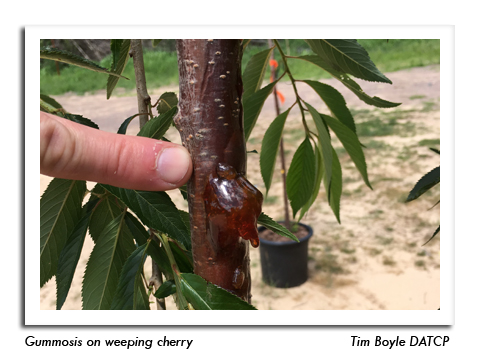
 |
|
|
Nursery & Forest
Volume 62 Number 15 Date 08/10/2017 CHERRY TREE GUMMOSIS - Exuded sticky, amber-colored gum or sap, referred to as gummosis, was noted on container-grown 'Pink Snow Showers' weeping cherry trees in a Wisconsin growing field. Gummosis is a tree's defense response to insect, bacterial, or abiotic stress and is often associated with cankers caused by mechanical injuries (such as contact with mowers or pruning), insects, winter damage, sunscald, herbicide injury, and various other fungal or bacterial infections. This disorder is most common on stone fruit trees such as cherries, nectarines, plums and peaches. Severe damage or infection may cause systemic wilting and eventual death of fruit-bearing wood. Prevention is best accomplished using an integrated management approach: avoiding mechanical injuries, pruning under dry conditions, providing a good growing site with well-drained soils and balanced fertilization. Practicing good sanitation by proper pruning and destroying cankered limbs is key. HOSTA VIRUS - Viruses affecting hosta, such as those from hosta virus X, continue to be reported throughout the state. Some plants are now showing symptoms which may have been masked by their variegation. Careful observation of plants before purchase and during their growing stages is recommended, and use of only certified virus-free stock is highly encouraged. DOGWOOD SAWFLY - Larvae were observed on the foliage of redosier dogwoods in La Crosse County. At this time of year, defoliation has usually progressed to the point that most leaf tissue has been fully consumed and only the midvein remains. Chemical control is effective against early-instar larvae (less than ¾ inch), but that treatment window has closed for this season. Varieties most susceptible to sawfly infestation are the gray and redosier dogwoods. OAK WILT - Symptoms of oak wilt have become evident where the disease occurs in northern Wisconsin, making late summer an opportune time to assess oak stands for damage. This lethal oak disease is spread by pruning or wounding oaks during the spring and summer months, which allows the sap-feeding beetle vectors to introduce the fungus to healthy trees. Once introduced into an oak stand, the fungus can spread underground through grafted roots. Symptoms are more pronounced in red oaks as the leaves turn brown and wilt in a short period of time, while white oaks have additional defenses against the fungus and the effects are less conspicuous. It is strongly recommended that residents and foresters do not prune oak trees until late fall or winter in areas where the disease is established. Oak wilt has been confirmed in 61 of Wisconsin's 72 counties. JAPANESE BEETLE - Nursery operators and homeowners continue to report severe damage to linden trees, roses, and numerous other ornamental plants. Adequate soil moisture levels favored grub survival from last season and may be one of the factors contributing to the outbreaks this season. Peak emergence has occurred in most areas and populations should decline by the end of the month. -- Tim Boyle, Marcia Wensing, Konnie Jerabek and Timothy Allen, DATCP Nursery Inspectors 




|
|
|